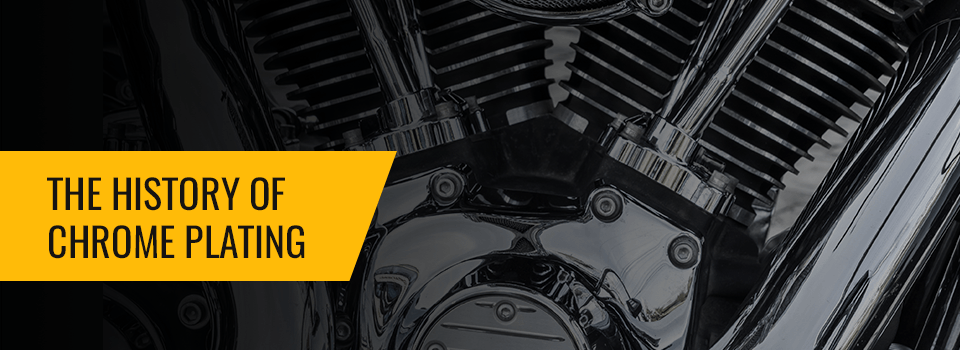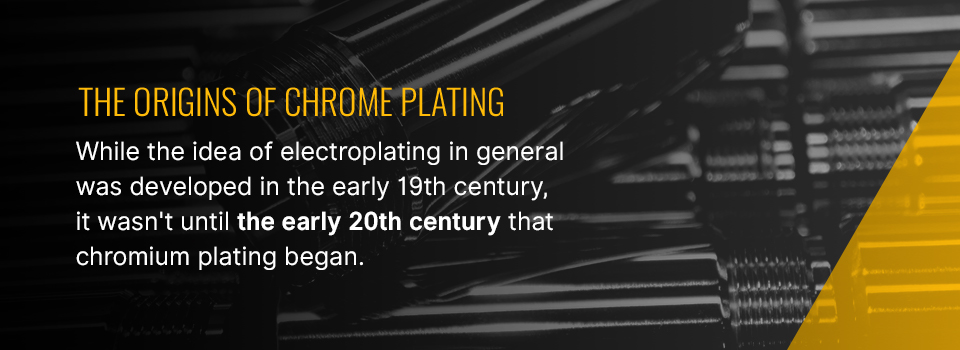The History of Chrome Plating

What do you picture when you hear the word “chrome”? For most people, chrome is a very positive word. It stirs up images of sleek, shiny, reflective metal that always looks new. Manufacturers may think of chrome as a lifesaver for making their products stronger and more durable. Most chrome products aren’t actually made of chrome all the way through — they are electroplated with a layer of chrome. This layer can transform a product, both aesthetically and functionally.
It’s no wonder chrome plating is a popular process. Let’s take some time to look back and learn more about who invented chrome plating and how the plating process has evolved over time.
Explore the Rest of Our Hard Chrome Plating Guide:
- Benefits of Hard Chrome Plating
- Hard Chrome vs. Decorative Chrome Plating
- Common Chrome Plating Problems
The Origins of Chrome Plating

Before we learn when chrome plating was invented, we have to go all the way back to the early 19th century, when electroplating was first discovered. An Italian chemist named Luigi Brugnatelli discovered that submerging metallic objects into a solution of dissolved gold and applying a charge with a Voltaic pile caused the gold to cover the surface of the objects. A Voltaic pile was the first electrical battery that was able to provide uninterrupted electricity to a circuit.
Brugnatelli shared his findings in 1805 in a Belgian scientific journal, but the scientific community did not embrace this discovery. One concern, held by Napoleon Bonaparte, was that lower classes would be able to use the process to have gold-plated belongings. Electroplating did not begin to be widely used until it was rediscovered a few decades later. It quickly became a popular way of creating jewelry, relics and more that appeared extremely valuable but were affordable to broader populations. In addition to gold, other types of metal plating, like nickel plating, became popular.
While the idea of electroplating in general was developed in the early 19th century, it wasn’t until the early 20th century that chromium plating began. One of the pioneers of chromium plating was George J. Sargent, who earned his doctorate degree in 1912 by studying chromium deposition. His studies led to Colin Fink and Charles Eldridge developing a commercial process for chromium plating in the following decade.
By the mid-1920s, there were two companies advertising their chromium plating services: The Chemical Treatment Company in New York and the Chromium Products Corporation in New Jersey. These two companies quickly merged, forming the Chromium Corporation of America. Following some patent interferences, the Chromium Corporation of America merged with a new company, General Chromium Corporation, and formed United Chromium, Incorporated in 1927.
It’s clear to see these early companies had high hopes for the success of chromium plating, and they were right. Chromium plating’s popularity took off rapidly. When something was chrome, consumers knew it would have a shiny, sleek appearance and would be more durable with greater corrosion resistance.
How Chrome Plating Has Changed Over the Years
It’s no wonder manufacturers and consumers embraced chromium plating — or, as it came to be known, simply — chrome. Chrome could be applied to nearly anything to improve its appearance and durability. Cars, bicycles and motorcycles, among other products, started rolling onto the market with sleek chrome parts.
During World War II, the use of metals like chrome was partly put on hold, but after the war, it resumed in full force. In fact, the French government created a Center of Information on Hard Chromium just after the war, which gave the world a comprehensive textbook on the topic in 1952.
Chrome was a common design feature of many objects in the 1950s. Picture a mid-century diner, for instance. Bar stools, trim on the bar and tables and even exterior features on the building were often chrome. Throughout the 20th century, up to today, chrome has continued to be a common finishing feature for everything from automobiles to doorknobs to sink faucets. You may not see it in all the places you would have in the 1950s, but the sleek appearance of chrome isn’t likely to ever go out of style.
When chrome is used purely for aesthetics, it is known as decorative chrome plating. Decorative chrome plating is done differently than hard chrome plating, which is also sometimes called engineering or functional chrome plating. When chrome is applied for aesthetic purposes, it goes on in a much thinner layer than when it is meant primarily for practical purposes. Hard chrome plating is often applied to components and tools that need to hold up to a lot of wear, like hydraulic cylinders, for example.
The way chrome plating is done has evolved since it was first developed in the ’20s. Originally, hard chromium plating was done by painstakingly calculating the surface area of an object to be plated and supplying the appropriate level of current to achieve the required current density at a known speed. Marvin J. Udy challenged this process by claiming that all chromium plating could be done with the same voltage level.
Along with Phil Hale, Udy set out to prove his hypothesis by attempting to plate various parts all at the same time with the same current to all of them. He found that “if you have a definite known electrode spacing and apply a constant voltage, the current density will be constant.” A successor named Clarence H. Peger gave the system its name, the Reversible Rack 2 Bus Bar System, and helped to popularize it.
Around the same time, T. H. Webersinn was experimenting with the trivalent process of chrome plating, which he intended to be an improvement over ordinary hexavalent baths. The process was, in fact, easier and more cost-effective. However, it resulted in a darker, less appealing surface appearance. Trivalent chromium more closely resembled stainless steel. Other issues were that the chromium didn’t adhere well in thicker layers and was porous, causing a lack of durability.
Over time, the “recipe” used for trivalent chromium plating was refined. Today, companies use additives to achieve the right color. Depending on the chrome plating applications, both trivalent and hexavalent solutions are used today. Hexavalent solutions are still preferred for most heavy-duty applications.
Chrome Plating From Hard Chrome Specialists
Chrome plating is a science, and as such, it has a scientific past — one of discovery, experimentation and continuous improvement. At Hard Chrome Specialists, we understand the intricacies of chrome plating and how to deliver the best results for our clients. Our advanced chrome plating baths allow us to carefully control the plating parameters to achieve exact specifications in the thickness and hardness of chrome coatings.
We’ve been providing the East Coast with hard chrome plating since 1988, so we have the expertise to help you find the perfect plating solution for your components and deliver that solution to you. Contact us today to learn more.

